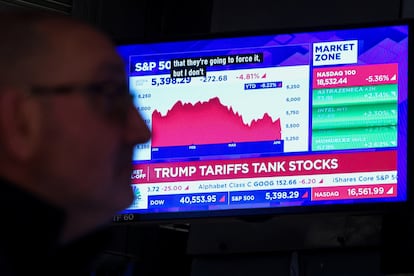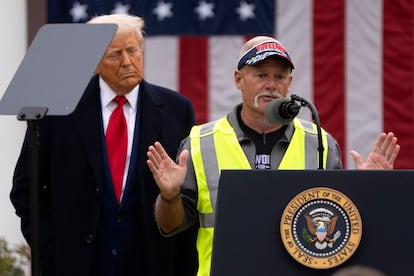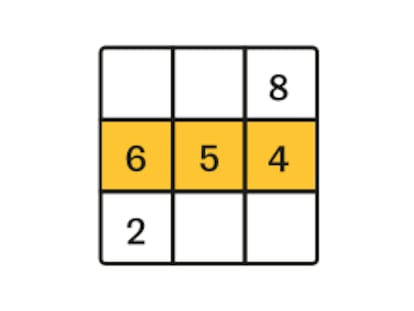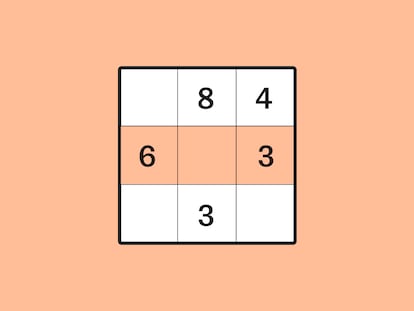How Trump’s tariffs are affecting the market: The stampede that wiped $5 trillion off Wall Street
Global markets are facing their worst days since the pandemic, with Trump’s harsher-than-expected trade war stoking fears of a recession, triggering panic among investors, and causing an economic earthquake

The global economic landscape was turned upside down on Wednesday. The pivotal moment of the inaccurately-called “reciprocal tariffs” didn’t come with a formal announcement, but rather when Donald Trump, after a 30-minute speech outside the White House, unveiled a poster listing the tariffs he would impose on imports from around the world (including uninhabited islands).
The percentages, far higher than economists and investors had anticipated, represent the most significant commercial change of tack since World War II, forcing a major recalibration of global economic parameters. Within minutes, financial markets on 24-hour trading platforms plummeted (Wall Street had closed trading shortly before the announcement). Over the next two days, the U.S. stock market, as measured by the S&P 500 index, dropped 10.5%, erasing more than $5 trillion in value (around €4.5 trillion) — a sum greater than the combined annual GDPs of Spain and France. These have been the hardest days for the stock market since the pandemic and they rank among the worst in the 21st century.
And the storm shows no signs of subsiding. The panic mode in which global markets ended last week was still gripping the stock exchanges on Monday, when the losses continued to intensify. It’s a grim day across all markets: Asian stock exchanges are suffering hits ranging from 7% to 12%, while Wall Street futures point to declines of around 5%. The German stock market is down 8.9%, the French market down 6.8%, and the British market down 5.7%; the Euro Stoxx 50 index fell 6.92% half an hour into trading.
The shock is spreading to other assets, with bond yields continuing to drop, the dollar weakening, and oil falling 4% to $63 per barrel of Brent, its lowest in four years. There are no signs of any concession from Donald Trump and fears of a worldwide recession are spreading.
What is a trade war, and why are the declines so sharp?
Economists often say that trade wars have no winners. In today’s globalized economy, when two countries impose import tariffs, they disrupt the operations of both small and large businesses. They are import taxes, so businesses pay more for everything that comes from abroad and receive less for exported goods. Consumers end up paying more for items that are manufactured either wholly or partially overseas. With potential European retaliation looming (and China already having announced its own), the economy has been impacted in several ways — all negative.
Firstly, tariffs generate inflation, as the vast majority of goods we buy contain components made abroad — whether it’s a newspaper, our cell phone, the glasses we’re wearing, the clothes we’re using, or even the coffee we drank this morning. Tariffs also stifle growth because higher prices mean households consume less, while businesses, pressured by higher costs and weaker external demand, invest less, earn less, and possibly hire fewer workers. Markets respond to both the specific outlook for affected companies and the broader environment of slower growth and rising inflation.
But it was known that Trump would impose tariffs…
Trade policy has been punishing U.S. markets for weeks. Trump had already imposed tariffs on imports from Mexico and Canada, as well as on the automotive, steel, and aluminum sectors. As a result, in the first quarter, European stock markets outperformed their U.S. counterparts by the largest margin in 10 years (7% versus a 5% decline).
Investors had already factored in the announced tariffs and those expected on April 2, but the reality was harsher than anticipated. The announcement was more severe than expected, both in terms of its global scope and the high rates applied — particularly for the European Union (20%) and China (34%). This marks the largest tariff increase since the Great Depression. The market had predicted an average tariff of around 15%, but the actual rate will likely approach 25%. The shift for the global economy is monumental: at the end of 2024, the average U.S. tariff stood at just 2.5%.
What are analysts predicting?
The calculations are indicative; the final impact will depend on whether the tariffs are fully implemented, potential retaliation, exchange rate fluctuations, how the costs are passed on to prices, and how households and businesses adjust their budgets. Regardless, experts predict that the U.S. economy could experience a GDP decline of between one and 1.5 percentage points, potentially pushing the country into recession as early as this year.
“The impact on GDP depends on retaliation by trading partners and how the tariff revenues get used. Tariffs are a regressive tax. They will hit lower-income households more as a share of their spending,” explains Standard & Poor’s.
Regarding inflation, prices could rise by as much as 4% to 5% year-on-year, which would make it difficult for the Federal Reserve to ease or lower rates to stimulate the economy. For Europe, in the absence of trade retaliation, the primary impact will be on growth, due to reduced exports. Goldman Sachs estimates this will cost the EU seven-tenths of GDP, while Citi has downgraded its growth expectations for the region by 1%.
Federal Reserve Chairman Jerome Powell warned on Friday that the economic effects of the tariffs will be “significantly larger” than expected and will result in lower growth and higher inflation.
In any case, economies are entering uncharted territory. “We should be wary of the appearance of false precision — this tariff shock is unprecedented at the global level dynamics in play [are] extremely complicated," warns UBS. “Our tariff model [...] does not account for the demand shock aspects of tariffs: the uncertainty and risk premium that arise from everyone adjusting expectations of income and spending/investment to a brave new world, in particular one where, in contrast to the usual safe-haven effects, the global role of the dollar wanes significantly. This second dimension of the tariff shock is likely to be even more potent than the first one.”

Which sectors are most affected by the fall?
Initially, companies with the most internationalized supply and sales chains were hit hardest. An example is sports accessory companies like Nike, which manufacture their products in Southeast Asia and sell them in the United States. Apple also saw a sharp decline, as its devices, though designed in California, are assembled in Asia using Asian-made components. The automotive sector hasn’t experienced a sharp drop last week, as tariffs on cars had already been imposed. BMW is down 13% for the year, and Stellantis has fallen by 30%. Now, the declines are spreading to other sectors, such as banking and energy.
How have other markets reacted?
Beyond the stock market declines, the bleak economic outlook is being reflected in almost every tradable asset. Government debt is seeing a sharp drop in interest rates, partly because money is fleeing riskier assets in favor of safer havens like Treasury bonds, and partly because investors are anticipating a slower-growing economy where interest rates should be lower. The price of oil and raw materials is also falling sharply as global economic growth is expected to slow.
In contrast, the price of gold is rising, serving as a safe haven amid stock market turmoil. In the foreign exchange market, as the economic downturn is expected to hit the U.S. hardest, the euro is strengthening against the dollar, reaching its highest level in 10 years on Thursday. It is now trading at 1.10 per euro, having briefly reached parity earlier this year.
Why is Trump proposing such aggressive tariffs if they hurt the economy?
The negative effects of imports have been a fixation for Donald Trump since the 1980s, and little has changed. The frustration of cities where factories have closed and populations have dwindled — places left behind by globalization — lies at the heart of the Trump movement, both in terms of his electoral base and his political and cultural rhetoric. A Detroit automaker employee participated in Wednesday’s announcement, while two dozen workers were invited to the ceremony. Trump’s theoretical approach is to reindustrialize the U.S. and revive the “Made in America” philosophy, but the president also prides himself on being a tough negotiator and has suggested that he could soften the tariffs if compensation is offered. However, reality is unforgiving; beyond the stock market crash and warnings from experts, layoffs have already begun at Detroit’s auto plants.
How long will the market decline last?
It’s a big unknown, but it largely depends on whether the tariffs are fully implemented, whether trading partners retaliate, and whether the White House ultimately reaches agreements with its trading partners. The market is uncertain about whether the announced measures are a starting point for negotiations or a substantive approach, and that’s the big question.
Unlike in his first term, Trump seems willing to tolerate stock market declines and the risks of disrupting the economic order (he has admitted that the U.S. would face a “transition period”). These statements, along with Wednesday’s announcement, have deepened market pessimism.
The coming weeks or months should provide more clarity. In any case, it’s important not to lose sight of the endgame: the U.S. stock market has enjoyed a 15-year streak of almost uninterrupted gains, nearly as expensive as during the dot-com bubble, so a correction in these valuations doesn’t necessarily have to be catastrophic. “Even before this week’s tariff shock, the global growth outlook had started to darken,” say analysts at Bank of America.
In this context, rather than waiting for Trump to change course, investors have opted to sell first and wait for further developments. One thing is certain, and widely agreed upon by experts: the turbulence will not ease anytime soon.
Sign up for our weekly newsletter to get more English-language news coverage from EL PAÍS USA Edition
Tu suscripción se está usando en otro dispositivo
¿Quieres añadir otro usuario a tu suscripción?
Si continúas leyendo en este dispositivo, no se podrá leer en el otro.
FlechaTu suscripción se está usando en otro dispositivo y solo puedes acceder a EL PAÍS desde un dispositivo a la vez.
Si quieres compartir tu cuenta, cambia tu suscripción a la modalidad Premium, así podrás añadir otro usuario. Cada uno accederá con su propia cuenta de email, lo que os permitirá personalizar vuestra experiencia en EL PAÍS.
¿Tienes una suscripción de empresa? Accede aquí para contratar más cuentas.
En el caso de no saber quién está usando tu cuenta, te recomendamos cambiar tu contraseña aquí.
Si decides continuar compartiendo tu cuenta, este mensaje se mostrará en tu dispositivo y en el de la otra persona que está usando tu cuenta de forma indefinida, afectando a tu experiencia de lectura. Puedes consultar aquí los términos y condiciones de la suscripción digital.
More information
Archived In
Últimas noticias
Most viewed
- Sinaloa Cartel war is taking its toll on Los Chapitos
- Oona Chaplin: ‘I told James Cameron that I was living in a treehouse and starting a permaculture project with a friend’
- Reinhard Genzel, Nobel laureate in physics: ‘One-minute videos will never give you the truth’
- Why the price of coffee has skyrocketed: from Brazilian plantations to specialty coffee houses
- Silver prices are going crazy: This is what’s fueling the rally









































